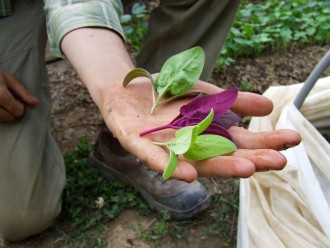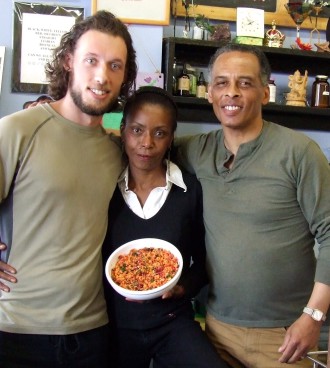In a consumer culture, generating waste seems to be an inevitable part of life. However, in a home kitchen, individual choice, creativity and mindfulness can change that. For local foodies, a zero-waste kitchen simply means a change in perspective: Skins, stems, pulp and bones, when seen for their potential, become much more than scraps.
What we often cull, throw away or compost can be the building blocks for new recipes, offering an infusion of flavor to many meals to come. And something deeper happens when we repurpose our scraps; something subtle. The commitment to use all parts of a plant or animal becomes a quiet ritual, one that honors the true value of food and acknowledges the work it took to grow, tend and transport it.
Expand your perspective
Gourmet chef-turned-farmer Evan Chender carefully rakes newly turned soil as the sun sinks, inching closer to the rolling green hills in the distance. “It’s the busy season,” he says, eyes on rich earth. “This was grass a few weeks ago.” For Chender, growing food is an art, a privilege and a practice that’s always evolving. Known professionally as the The Culinary Gardener, Chender grows organic specialty crops, edible flowers and flavorful curiosities (think borage, celtuce, fava-bean flowers, hand-tied curly endive and red sorrel, to name a few). For him, every part of the plant has culinary potential, and every tendril and leaf is valued.
“I think one of the biggest, formative experiences I’ve had with growing food is how precious and special it becomes just because you’re a part of the process. I’m way more apt to discard something, some part of a plant or something that’s a little bit past its prime, if I’ve gotten it from a grocery store and out of a bag from California. Being a part of it, from the seed to the harvest, in such a small space [means that] everything I do is extremely intimate.”
It’s important, says Chender, to have a broad perspective of food, to see beyond the aisle in which it’s sold. “Ask a farmer: How long did this lettuce grow? What was involved in getting it to this farmers market? What’s involved with getting a head of lettuce from Salinas Valley, Calif., here to Asheville?”
It’s exactly this perceptive that inspires Chender in his own kitchen. Scraps of fennel, when blanched for just two minutes, create a rich and flavorful stock that enriches any stir-fry or soup. “I love to use onion and garlic tops too,” he says. “Just simmer the greens for 20 minutes.” With root vegetables like radish and turnips, Chender treats the tops like mustard greens.
Sweet and savory with juice pulp
In alignment with a living-foods lifestyle, Judith Génécé-Murphy, who owns the Farmacy Juice & Tonic Bar at West Village Market with her husband, Carlysle Murphy, says that the key to health is found in balance. “We eat living foods, we juice, we do some cooked foods, because you don’t get your nutrients from just one source,” she explains. Juice pulp, something that’s often simply composted, can be repurposed for a number of dishes and is extremely rich in digestive enzymes and fiber, says Génécé-Murphy. “You can catch the residue of herbal greens like cilantro and parsley and add it to any kind of grain. Just enfold the herbs into the grain, pasta or pasta sauce, add a little nutritional yeast, sesame seeds and a little olive oil, and you’re adding enzymatic value to the cooked food.”
On the sweet side, Génécé-Murphy turns pulp into fresh fruit sauces and raw cakes. “With apples, we take the apple pulp and mix it with either raisins, any dehydrated fruit really, like currants or dates, and add lemon juice and powdered cinnamon. You blend that together and you have a wonderful apple sauce. You could add a little cayenne to it, if you wanted to be a little risqué.”
After a sip of vibrant green juice, Génécé-Murphy continues, “If you’re making a carrot-ginger juice, with apple carrot, pear and ginger, you could take the pulp of all of that to be your raw cake. Add chopped nuts like walnuts or almonds, and then add something to thicken it, like dates, and put that all in the blender. When it starts sticking to the side of the blender, you know it’s thickened enough to be molded. Pour it all into a muffin tin and refrigerate. You could add ground flax or chia seeds or even psyllium to the blend.”
Homemade flavor infusions
Local chef Matthew Miner, who has worked at both The Blackbird and Cúrate, stresses that there’s a plethora of nutrition that’s often tossed out with the scraps. “The majority of your vitamins and amino acids are right beside the skins of these things, so you’re pulling off nutritional elements when you peel a carrot or when you peel an apple or a potato,” he says. “For example you can take all your vegetable scraps — carrot tops, onions, celery tops, peppers, tomato scraps, leeks, parsley stems, potato peels — and make a stock with it.” Save the skins and scraps from meals in a zip-close bag in your freezer. Once the bag is full, submerge the trimmings in water, bring to a boil and let simmer for 20-30 minutes.
When filleting a salmon or working with a whole fish, Miner spoons out the flesh that’s close to the bone, saving each spoonful for a rich ravioli filling or mousse. “And, if you roast a whole chicken,” he says, “save it, and there’s the base for a chicken soup. Or, if you reduce it enough, you can use it as a demi-glace for a sauce.” For a bone stock, simply add water, bring it all to a boil and let it simmer for 40-50 minutes.
Changing our food culture

As a father, Miner is motivated to lead by example, and by using all he can, he’s teaching his son to respect his food. “What kind of statement are we making, and what kind of earth are we going to leave for our children?” Minor asks. “That to me is huge. It’s also very discouraging, because we’re extracting all that we can from the earth without giving back. If we at least take care of our little part of the world, then it adds up to something.”
Back in the garden, after sampling a tendril picked from a petite snap green, Chender muses, “I think we waste because there’s no culture of using every little bit. If you go to Italy, you’re not going to see someone trim a fresh porcini and throw out the trim, they’re going to make stock with it; they’re going to extract every little bit of flavor that they can from that precious crop.” He takes a deep breath and scans the garden. “For me, preparing the soil, weeding, thinning the plants out so they have the proper spacing, washing them, guarding them so they’re not getting eaten by slug or beetles, all this elevates the statue of the vegetable, almost to a status above myself, something that’s way greater than me. It’s humbling and inspiring, and I’m going to treat it with respect, a lot of respect. It’s changed my relationship with food.”






Great story, Aiyanna. I’ve also experienced that shift in how I view veggies after just two summers of gardening. It’s amazing, and really does make me want to use every last scrap of green (if I get that far).
Also, I’ve read that red onions’ outer skins are good for giving broth a deeper color, if nothing else..